Washbasin above the washing machine: the rules for selection
Is it possible to place a washbasin with a washing machine in one corner of the bathroom? What are the signs to choose a washing machine and sink with such a layout? Finally, are there any particularities in their installation in this case? Let's figure it out.

Why do you need it
The motivation for such an unusual bathroom layout is pretty obvious - lack of space. Since the time of the famous tour of Maestro Woland (the apartment question has only spoiled them, remember?), The situation has not changed for the better: the sanitary standards of living space are still small.
Note! Since the time when Mikhail Afanasyevich Bulgakov worked, in a typical family there was a significant increase in household appliances and household utensils. Both require a place that is sorely lacking.
A bathroom in a typical city apartment rarely has any significant area. The problem is especially acute in apartments with separate bathrooms and toilets.
In a miniature bathroom you need to place three pretty overall items:
- Actually a bath, occupying about half the area.
- Washbasin.
- Washing machine. Wash on hands, especially in a large family, and even after a hard day’s work, is clearly not comme il faut.
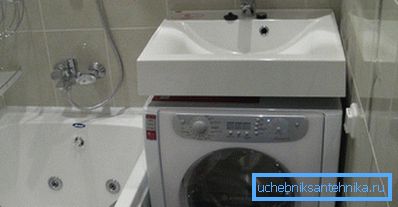
Go shopping
Washer
Our choice is a miniature machine with a height of about 60 - 70 cm and a depth of 35 - 43 centimeters. A typical load of such a baby does not exceed three kilograms of dry laundry.
To install a washbasin on a washing machine of standard (85 cm) height, in general, nothing interferes; however, the edge of the sink in this case will be at a height of 105 - 110 cm from the level of the finished floor. If your height is close to the average, comfortable use of such a shell is clearly not.
Another subtlety: the front side of the car ideally should not have noticeable rounding and protrusions. You are likely to rest your knees on any outstanding detail while washing.
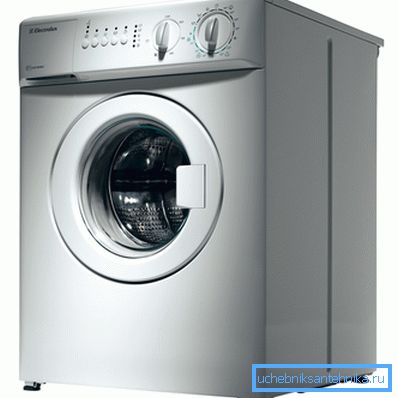
Sink
What should be the sink under the washing machine?
Dimensions
| The size | Recommendation |
| Height (distance from the top edge to the bottom of the release) | 15 - 20 cm. The smaller height of the sink bowl guarantees a huge amount of splashes on the floor and walls when washing; an increase in this dimension will again close the top edge of the sink, making the height uncomfortable for a person of average height. |
| Width | Ideally, one should exactly match the width of the washing machine. In this case, we will occupy a minimum of space; however, the cover of the machine will not be constantly flooded with water. |
| Depth (distance from the back wall to the front edge of the shell) | The front edge should protrude 3-5 cm beyond the front wall of the washing machine installed in the working position. |
It is useful to take into account a couple of other nuances:
- The washing machine is placed at some distance from the wall (usually about 5 cm). The instruction is related to its vibration during the spin cycle: the gap will prevent damage to the water supply and sewage pipes.
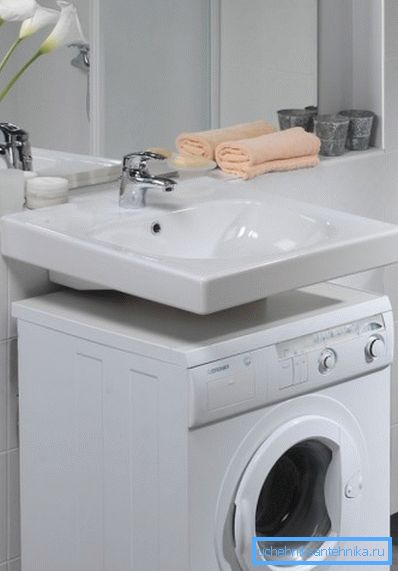
- The depth of the sink should allow the smallest member of the family to reach the taps or the lever of the mixer, not leaning forward and not transferring its own weight to the edge of the sink.
The form
Ideally, it should be square or rectangular: various rounds will either leave the lid of the washing machine open for spraying or take up extra space, which is already in short supply.
The main feature of the bowl suitable for our purposes washbasin - the location of the issue: it should be as much as possible shifted to the back wall. In this case, the siphon will be behind the machine.
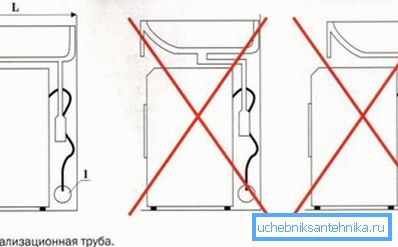
Material
The list of popular materials is small:
- Sanitary Wares. Its main advantage is the low price. The material is resistant to abrasives, acids and alkalis, but is relatively quickly contaminated.
- Porcelain more expensive than faience by 10 - 30%. For the difference in cost, the buyer gets a surface that gets dirty more slowly and is easier to clean thanks to the smaller pore size.
- Fake diamond (polymer concrete), in contrast to ceramics produced by calcining white clay, is a composite of stone chips and acrylic binder. It is somewhat stronger to shock loads, but it is easier to scratch and less resistant to aggressive cleaning agents.
Siphon
For our purposes, a corrugated siphon for a sink is ideal, which is a segment of a corrugated tube made of polyvinyl chloride and a retainer that allows you to organize a water seal in the bend of this tube.

Please note: a bottle siphon is more convenient than a corrugated one, which allows, if necessary, to quickly remove the accumulated dirt or remove the decoration that fell into the washbasin. However, in the narrow space between the machine and the wall, it simply does not fit.
Installation
Is it difficult to install a washbasin above a washing machine with your own hands?
No more difficult than any other sink in the bathroom. As a rule, in this case the fixing on the brackets is used: the pendant fixation will create a dangerous load on the washbasin material due to the too disadvantageous ratio of the sink depth and the height of the back wall; the pedestal, for obvious reasons, also disappears.
Tools and materials
We will have to prepare:
- Building level.
- Drill with a drill on tile.
- The puncher with the drill.
- Anchor (3 pieces per bracket).
Let us clarify: complete screws and plastic dowels will easily be kept by the washstand, but a person leaning on him in any respectable dimensions is likely to tear the fasteners out of the wall. That is why it is better to replace the screws with anchors. The standard fasteners will be useful for mounting the hook fixing the back of the shell.

- Hammer.
- Adjustable wrench for tightening anchors.
Sequence of operations
- Mark the position of the sink and brackets. The bottom of the sink should be separated from the lid of the washing machine by 2-3 centimeters. The horizontal position of the bowl on an axis parallel to the wall is controlled by level.
- Drill holes for the anchor. The tile is drilled on tile at minimum speed and with periodic wetting of the drill with water; then the holes are deepened by a bit smaller diameter (by the size of anchors).
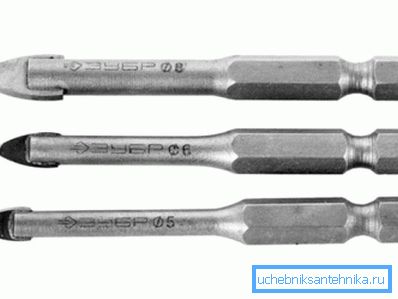
- We drive in the anchor, put brackets on them and wrap the nuts, leaving 5-7 millimeters of slack.
- We put a sink on the brackets and start a hook-lock in its rear groove, which will not allow the rear edge to rise when pressing on the front one. Mark up the point of its attachment to the wall. We drill a hole and drive a dowel into it.
- After removing the sink, we apply a couple of strips of sealant on its back wall, which will perform the function of a damper between it and the tile. Then we install the washbasin in place and reach the anchor, then fix the hook with a screw.
- We put in place the release and connect it to the sewer.

Nuance: if installation of an onboard mixer on a sink is supposed, it is mounted on it before final installation on brackets. Later it will be much more difficult to fix it on the sink.
Conclusion
We hope that the above simple recommendations will help the reader to make a successful purchase and cope with its installation. The video in this article will traditionally offer additional thematic materials. Successes!